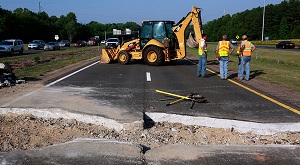U.S. grid buckling under the heat
 The dry desert landscape of apocalyptic films like Mad Max never seemed prescient to me. If anything, they had a retro-futuristic quality.
The dry desert landscape of apocalyptic films like Mad Max never seemed prescient to me. If anything, they had a retro-futuristic quality.But looking at pictures of a US Airways regional jet stuck in melting asphalt, or a derailed subway train thrown off a heat stretched track, made Mad Max’s once foreign imagery hit a little too close to home.
In East Texas, the clay-rich soil is contracting so quickly the highways are cracking open.
Who knew heat would be the deadliest natural disaster in the United States?
“Between 1979 and 2003, heat waves killed at least 8,015 Americans, according to the Centers for Disease Control and Prevention,” writes Brad Plumer of The Washington Post. “That’s more than hurricanes, lightning, tornadoes, floods and earthquakes combined.”
The rise in extreme weather means old strategies for infrastructural growth and development need to be reassessed or scrapped.
“We’ve got the ‘storm of the century’ every year now,” said Bill Gausman, a senior vice president and a 38-year veteran at the Potomac Electric Power Company. The June 29 “derecho” storm that hit the Midwest and traveled to the Eastern Seaboard knocked out power for 4.3 million people in 10 states and the District of Columbia.
The Potomac Electric Power Company took eight days to recover.
Highways are designed for climate patterns we are no longer experiencing. As local climates change, “All bets are off,” said Mr. Scullion, the senior research engineer with the Texas Transportation Institute at Texas A&M University. “We could have some very dramatic failures of highway systems.”
Vicki Arroyo, who heads the Georgetown Climate Center at Georgetown University Law Center in Washington, urged the federal government to do more. “They are not acknowledging that the future will look different from the past,” she said, “and so we keep putting people and infrastructure in harm’s way.”
David Behar, the climate program director for the San Francisco Public Utilities Commission, said: “We’re living in an era of assessment, not yet in an area of adaptation.”
You can return to the main Market News page, or press the Back button on your browser.

